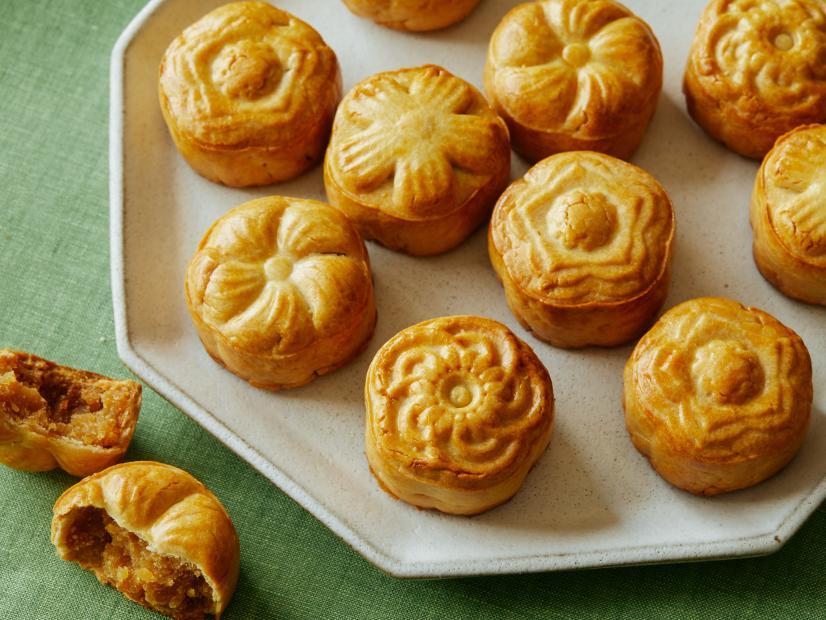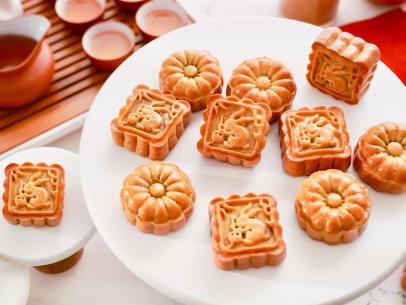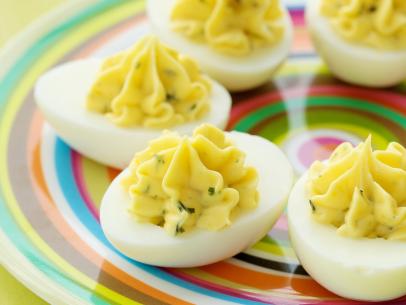
Mooncakes
- Level: Advanced
- Total: 11 hr 55 min (includes soaking and cooling time)
- Active: 1 hr 20 min
- Yield: 12 mooncakes
-
- Nutritional Analysis
- Per Serving
- Serving Size
- 1 of 12 servings
- Calories
- 204
- Total Fat
- 10 g
- Saturated Fat
- 2 g
- Carbohydrates
- 29 g
- Dietary Fiber
- 0 g
- Sugar
- 15 g
- Protein
- 2 g
- Cholesterol
- 16 mg
- Sodium
- 11 mg
- Level: Advanced
- Total: 11 hr 55 min (includes soaking and cooling time)
- Active: 1 hr 20 min
- Yield: 12 mooncakes
-
- Nutritional Analysis
- Per Serving
- Serving Size
- 1 of 12 servings
- Calories
- 204
- Total Fat
- 10 g
- Saturated Fat
- 2 g
- Carbohydrates
- 29 g
- Dietary Fiber
- 0 g
- Sugar
- 15 g
- Protein
- 2 g
- Cholesterol
- 16 mg
- Sodium
- 11 mg
Ingredients
Lotus Paste:
Mooncake Dough:
Directions
Special equipment:
a plastic 2-inch wide miniature mooncake press mold or 4-hole wooden mooncake mold- For the lotus paste: Place the dried lotus seeds in a medium bowl and cover with plenty of room temperature water. Let the seeds soak and rehydrate for at least 6 hours, and preferably overnight.
- Rinse the lotus seeds under cold water, then split them in half to remove and discard the green sprout in the center (they are very bitter). Transfer the seeds to a large pot and fill with plenty of water. Bring to a boil over medium-high heat, then reduce to medium-low and simmer until the seeds are tender enough to smash with a fork, about 1 hour. Drain well, then transfer the seeds to a food processor while they are still warm, add 3/4 cup sugar and puree until very smooth. (Add 1 to 2 tablespoons water if necessary to get a very smooth texture). Strain through a fine mesh sieve into a medium bowl.
- Melt 1 tablespoon vegetable shortening and the remaining 2 tablespoons sugar in a medium nonstick skillet over medium-high heat, then cook until caramelized and deep golden, about 5 minutes. Add the lotus puree and cook, stirring continuously, until most of the moisture has been cooked out and the puree is similar in texture to thick mashed potatoes, 6 to 8 minutes. Add the remaining 1/3 cup vegetable shortening, then continue to cook, stirring continuously, until all of the shortening has fully incorporated and the paste is very thick, glossy and pulls away from the sides of the pan, about 6 minutes more. (The final lotus paste should be amber brown in color and almost stretchy in texture.) Transfer to a medium bowl and let cool completely.
- For the mooncake dough: Meanwhile, whisk together the golden syrup, alkaline water and vegetable oil in a large bowl until combined. Add the cake and all-purpose flours, then stir with a wooden spoon until a shaggy dough forms. Gently knead the dough until it comes together completely, then wrap in plastic wrap and set aside to rest, about 45 minutes.
- Preheat the oven to 350 degrees F. Line a baking sheet with parchment paper.
- Divide the lotus paste into 12 equal pieces (each about 2 1/2 tablespoons) and roll into golf ball-size balls. Place on a plate and chill in the refrigerator, 20 to 30 minutes. The colder the balls, the easier it will be to shape the mooncakes.
- Roll about 1 tablespoon of the mooncake dough into a ball, then place between 2 pieces of parchment paper that have been lightly dusted with flour. Use a rolling pin to flatten the dough to about 1/8 inch thick and 3 1/2 to 4 inches wide. Place one of the lotus paste balls in the center of the dough, and shape the dough around it, pinching the edges to seal. Roll the ball in your hands to smooth the exterior.
- Place the assembled ball in a plastic 2-inch wide miniature mooncake press mold, then turn the press upright on your work surface. Press the plunger down until you feel resistance, then lift the mooncake mold off the table and use the plunger to carefully press the mooncake out. Transfer to the prepared baking sheet, then refrigerate while you make the remaining mooncakes in the same manner.
- Bake the mooncakes until the tops are no longer shiny and the dough has just set, 10 to 12 minutes. Let cool 10 minutes. Whisk the egg together with a splash of water in a small bowl, then brush over the tops and sides of each mooncake. Return to the oven and bake until deep golden brown, 10 to 15 minutes more. Let cool on the baking sheet 10 minutes, then transfer to a rack to cool completely. Enjoy fresh or store in an airtight container for 2 days (they'll get shinier as they sit).
Cook’s Note
Golden syrup is an amber-colored syrup made from sugar with a much richer texture and deeper aroma than simple syrup. It also contains acid, which helps make the mooncake pastry tender. Alkaline water -- also known as kansui, or jian sui in Chinese -- is an alkaline solution made from sodium carbonate and potassium carbonate. It is often used in Asian pastries and ramen noodles. It acts a bit like baking soda, keeping dough fluffy and moist without introducing too much gas. It also adds a yellow color to dough (like making egg noodles without egg). In mooncakes, alkaline water neutralizes the acid in the golden syrup, so the dough doesn't taste sour.

































